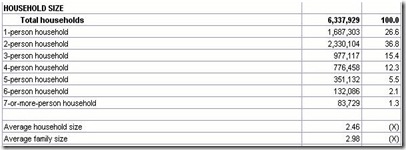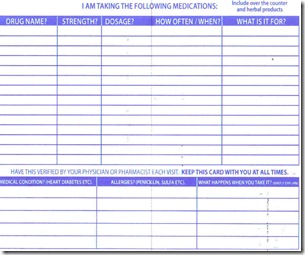# 3389
Nearly 1 person in 10 in the United States lives alone. That’s roughly 27 million adults.
Add to that the number of households with one adult caring for one or more minor children or caring for elderly, disabled, or otherwise unable to fend-for-themselves individuals, and the number goes up dramatically.
During a pandemic (even a relatively mild one), households with only one responsible adult (regardless of the number of inhabitants) are going to be at greater risk.
In Florida, where I live, the problem is particularly acute, as we have a large elderly population, many of whom live alone.
Florida Households (2000 Census)
While the H1N1 virus has proved to be `relatively mild’ for the vast majority of people infected, that term may be a just a bit deceptive.
`Mild’ generally means not requiring hospitalization.
It doesn’t mean that this flu won’t knock you on your backside for 4 or 5 days. And while the vast majority will recover, that assumes some basic level of care.
Something that some flu victims may be unable to provide for themselves.
It doesn’t take long for the flu, with its fever (and sometimes vomiting and diarrhea), to begin to dehydrate even healthy individuals. Dehydration, if it isn’t reversed, can become a serious, even life threatening condition.
In my essay, The Rehydration Solution, I go into detail about the need to keep flu patients hydrated. It may very well be the single most important thing you can do for a flu victim.
You can make your own rehydration solution by adding 8 teaspoons of sugar, and 1 teaspoon of salt, to 1 liter (or quart) of water. You can add unsweetened flavoring (Kool-Aid or Crystal Light) to improve the taste.
But for this to work, it has to be administered.
And if someone is already dehydrated or otherwise incapacitated by the flu, they may be unable to do that for themselves.
All of this points out the pressing need for those that live alone, or who are the sole responsible adult in a household, to establish a pandemic `safety net’ with friends, relatives, or neighbors by arranging to have (and to be) a `Flu Buddy’.
A `Flu Buddy’ is simply someone you can call if you get sick, who will then check on you every day, make sure you have the medicines you need (including fetching Tamiflu if appropriate), help care for you if needed, and who can call for medical help if your condition deteriorates.
Those people who are charged with the care of others, like single parents, also need to consider who will take care of their dependents if they are sick.
Once again, having a flu buddy or two, who could help with those matters, could prove invaluable.
I am already a `Flu Buddy’ to several relatives and close friends. I know that in return, should I be stricken with this virus, that I have several people who will be willing to look out for me as well.
Should the pandemic hit my neighborhood hard, I also plan to phone or to knock on my neighbor’s doors every day to check on them.
If the projection of 1/3rd of the country falling ill due to this virus over the next 12 months is anywhere close to accurate, then 100 million people will be sickened in the United States alone.
Almost all of these people will have to be treated at home. Our hospitals lack the capacity to treat more than a minor fraction of these cases.
If you haven’t already done so, now is a good time to download Dr. Grattan Woodson’s free guide on the treatment of Influenza, available from his website.
You should read this guide now, and lay in the supplies you might need should you, or someone in your care, catch the flu.
I strongly recommend putting together a `flu box’, to keep under your bed this winter. Influenza can hit so rapidly, that you can literally wake up too sick to get out of bed.
Having a `flu kit’ within reach could be a godsend.
In mine I keep a couple of small bottles of water, some Tylenol and ibuprofen, a thermometer, some over-the-counter flu remedies, and even a few surgical masks (for me to wear if someone visits to help care for me).
If you haven’t done so, you should also have a written medical history on yourself, and anyone in your household (see Those Who Forget Their History . . .)
Many hospitals and pharmacies have easy to fill out wallet history forms available for free, or for a nominal charge.
I also recommend having a phone near the bed, and the numbers of your `flu buddies’.
That can be lifesaving in itself.
The idea behind flu buddies is that it is reciprocal. You need to be willing to perform the same service in return.
You should also consider having, and being, flu buddies with more than one person.
Businesses, as part of their pandemic planning, should be encouraging employees to help one another in a crisis. To, at the very least, check on anyone absent during a pandemic.
Churches, civic organizations, and other groups would do well to consider the idea as well.
Those that are so inclined may wish to volunteer to help with the American Red Cross, The Medical Reserve Corps, CERT, or your Neighborhood watch. Your community needs your help in a crisis, not just the people you know.
It’s an old fashion idea, that we should look out for the welfare of our friends, neighbors, relatives and even our greater community.
But in a crisis, like a pandemic, it is still an extremely good one.


